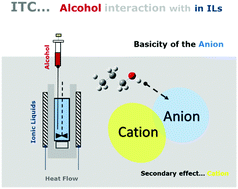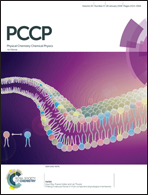Solvation of alcohols in ionic liquids – understanding the effect of the anion and cation†
Abstract
In this work, we studied the effect of anion and cation properties on the interaction of alcohols with ionic liquids (ILs), using propan-1-ol as a molecular probe. The enthalpies of solution at infinite dilution of propan-1-ol in several ILs were measured by isothermal titration calorimetry (ITC). The calorimetric results were analysed together with molecular dynamics simulation and quantum chemical calculations of the interaction of the hydroxyl group of propan-1-ol with the anions. The results evidenced the role of the anion's basicity in the intermolecular interactions of alcohols and ionic liquids and further revealed a secondary effect of the cation nature on the solvation process. The effect of the anion basicity on the strength of the interaction of alcohols with ionic liquids was evaluated by comparing the results obtained for ILs with the same cation and different anions, [C4C1im][anion] (anions NTf2, PF6, FAP, DCA and TFA). The effect of the cation (size, aromaticity, charge distribution, and acidity) was explored using five different cations of the NTf2 series, [cation][NTf2] (cations C4C1im, C4C1pirr, C4py, C4C1pip, and C3C1C1im).



 Please wait while we load your content...
Please wait while we load your content...